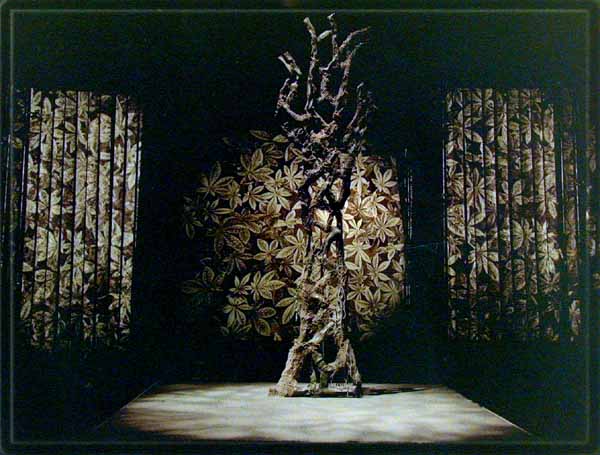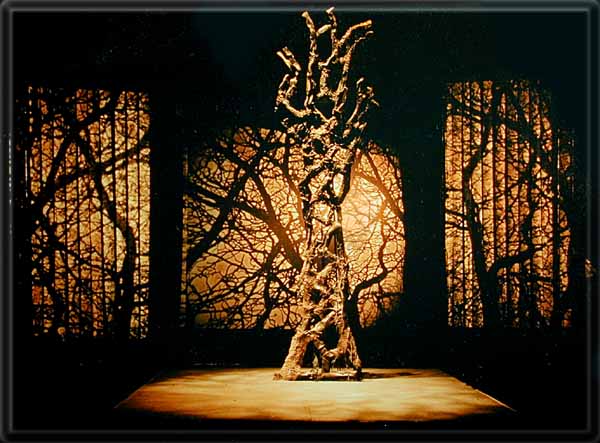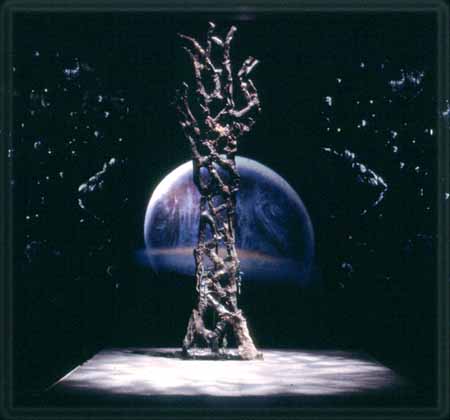The space was arranged on rather formal geometries.
There was a gloss black platform area about 24 foot square on which
sat a second, gray-carpeted, square platform. The carpeted platform
was not centered on the black platform and thus provided for variation
in the surrounding playing space.
Within the set of Evening, a tree was suggested in the
center of the space. This tree was rigged to fly in through the
egg-crate catwalk system we had built for the theatre. The tree was
very textured and dimensional but through a unique stylization, it was
possible to see through the tree to action beyond.
Framing the stage, I used a type of slit metallic
scrim-like material to produce a front-projection surface of
exceptionally high gain. It allowed me to use off-the-shelf blimped
300 watt Kodak Ektagraphic projectors from the front to balance the
1100 watt Buel Hi-Light projector used in the center in a rear-screen
configuration. The noise of the Buel projector was muted by the screen
and the distance.
As in the case of Mr. Pielmeier�s most known play,
Agnes of God, Evening is centered in the arena of personal
relationships, but unlike Agnes, this play is very delicate in its
explorations. The action covers a couple in love in Appalachia from
the time of their youth in school. While there are many characters in
the play the action centers most directly on the two of these
individuals.
The play is infused with the folk idiom of the Appalachian
life from dulcimer playing to the dialects. The play is very personal
and poetic in its use of language. One must wonder if there are
autobiographic elements in this work. The play is charged with emotion
as the relationship is explored through happy moments and moments of
great turmoil in the relationship.
While I often view my job as designer through terms of
supporting movement themes, in this case the task was largely to
support the emotive themes. To reflect the spare poetry of the
dialogue I opted for the simplest of environments, an actor on a
platform in front of an audience. I used the essence of the tree to
capture the feeling of being in love in a meadow. The set is designed
to be intensely light reactive, allowing it to change and support the
myriad of complex changes of mood and dramatic texture.
This scheme also allowed for effective support for the
other new plays in the repertoire of the festival. Many of the photos
on the projection test example page reflect the setting for Sandra
Pearlman�s play, Uniform Love. In many ways this play was the
antithesis of Evening. While Evening was delicate, Uniform love was
most brash. While Evening was set in the country in a time of self
reflection, perhaps the 1940s or early 1950s, Uniform Love was clearly
a suburban play set in the 1960s.
While Evening is serious in its exploration of the
human condition, Uniform love is a mad romp, a fast-paced tv-sketch-like
ditty. The action involves a bored housewife who will do anything for
a man in uniform.
In the design of Uniform Love, the basic environment
was maintained, however select changes were made that provided a
simple, but marked contrast in emotive underpinning. The upper
platform was rotated to a 45 degree angle. It�s texture was changed
from that of a neutral carpet to a brash suggestion of 1960s linoleum
run amok. The organic form of the tree was replaced with calculated
white recti-linear forms of the 1960s suburbs. The space becomes the
essence of the "little box made of ticky-tacky."
The projections too are wrought in different styles to
reflect the styles of the shows. The projection work for Evening is
organic, and reflects the rich colors of the mountains of Kentucky in
the spring and fall. The projections for Uniform Love were angular and
typified by the funky color combinations so popular in the
"mod" era.



